A fragment of a large, long-period comet was most likely responsible for the impactor that killed off the dinosaurs.



Changing literally everything to get emissions to zero.
“Without innovation, we will not solve climate change. We won’t even come close,” Gates says. Anderson Cooper reports for 60 Minutes. https://cbsn.ws/3qnNDyG
Watch Full Episodes of 60 Minutes HERE: http://cbsn.ws/1Qkjo1F
Get more 60 Minutes from 60 Minutes: Overtime HERE: http://cbsn.ws/1KG3sdr.
Relive past episodes and interviews with 60 Minutes Rewind HERE: http://cbsn.ws/1PlZiGI
Follow 60 Minutes on Instagram HERE: http://bit.ly/23Xv8Ry.
Like 60 Minutes on Facebook HERE: http://on.fb.me/1Xb1Dao.
Follow 60 Minutes on Twitter HERE: http://bit.ly/1KxUsqX
Get the latest news and best in original reporting from CBS News delivered to your inbox. Subscribe to newsletters HERE: http://cbsn.ws/1RqHw7T
Get your news on the go! Download CBS News mobile apps HERE: http://cbsn.ws/1Xb1WC8

Instead of firing missiles, planes may carry and launch unmanned drones that will be able to shoot their own missiles to search and destroy targets.
Aerospace giant Northrop Grumman is wasting no time in this competition.
Just two days after DARPA named it as one of three competitors for the LongShot contract, the company released an image of its concept for an air-launched unmanned aircraft system (UAS), Aviation Week reported.
Imagine an unmanned aircraft, speeding ahead of its launch aircraft, that itself can fire multiple air-to-air intercept missiles that can seek out and destroy.

Neil Tyson is a man to listen to!!
Check out his documentary series: COSMOS.
Like.
Using the pressure of the sun’s rays to propel spacecraft, solar sails will allow future unmanned missions to be longer and cheaper while reaching the outer solar system—and possibly beyond.
#Moonshot #Space #BloombergQuicktake.
——-
Like this video? Subscribe: https://www.youtube.com/Bloomberg?sub_confirmation=1
QuickTake Originals is Bloomberg’s official premium video channel. We bring you insights and analysis from business, science, and technology experts who are shaping our future. We’re home to Hello World, Giant Leap, Storylines, and the series powering CityLab, Bloomberg Businessweek, Bloomberg Green, and much more.
Subscribe for business news, but not as you’ve known it: exclusive interviews, fascinating profiles, data-driven analysis, and the latest in tech innovation from around the world.
Visit our partner channel QuickTake News for breaking global news and insight in an instant.

Definitely watch it for the sense of isolation when our technology bubble evaporates and for the “comb jelly” space alien.

Advances in astronomical observations have resulted in the discovery of an extraordinary number of extrasolar planets, some of which are believed to have a rocky composition similar to Earth. Learning more about their interior structure could provide important clues about their potential habitability.
Led by Lawrence Livermore National Laboratory (LLNL), a team of researchers aims to unlock some of these secrets by understanding the properties of iron oxide —one of the constituents of Earth’s mantle—at the extreme pressures and temperatures that are likely found in the interiors of these large rocky extrasolar planets. The results of their experiments were published today in Nature Geoscience.
“Because of the limited amount of data available, the majority of interior structure models for rocky exoplanets assume a scaled-up version of the Earth, consisting of an iron core, surrounded by a mantle dominated by silicates and oxides. However, this approach largely neglects the different properties the constituent materials may have at pressures exceeding those existing inside the Earth,” said Federica Coppari, LLNL physicist and lead author on the study. “With the ever-increasing number of confirmed exoplanets, including those believed to be rocky in nature, it is critical to gain a better understanding of how their planetary building blocks behave deep inside such bodies.”